A major solar flare measuring X1.3 erupted from Active Region 3663 at 06:01 UTC on May 5, 2024. The event started at 05:47 and ended at 06:09 UTC. This is the second X-class solar flare from this region since X1.6 at 02:22 UTC on May 3.
It doesn’t appear this flare produced a coronal mass ejection (CME). If it was, however, there is a chance we’ll see at least a part of it coming our way.
Radio frequencies were forecast to be most degraded over the Middle East, Asia, and the Indian Ocean at the time of the flare.
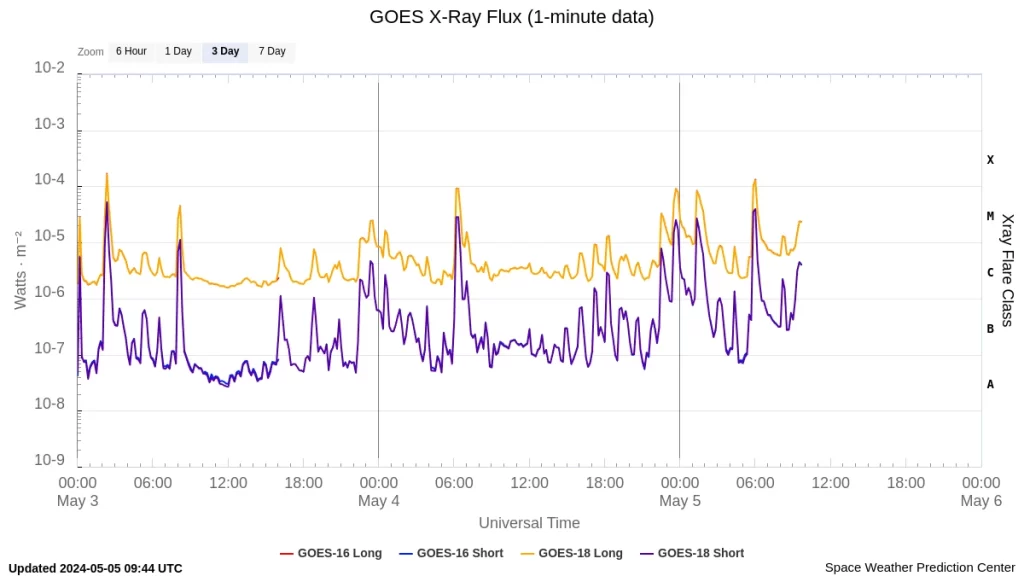
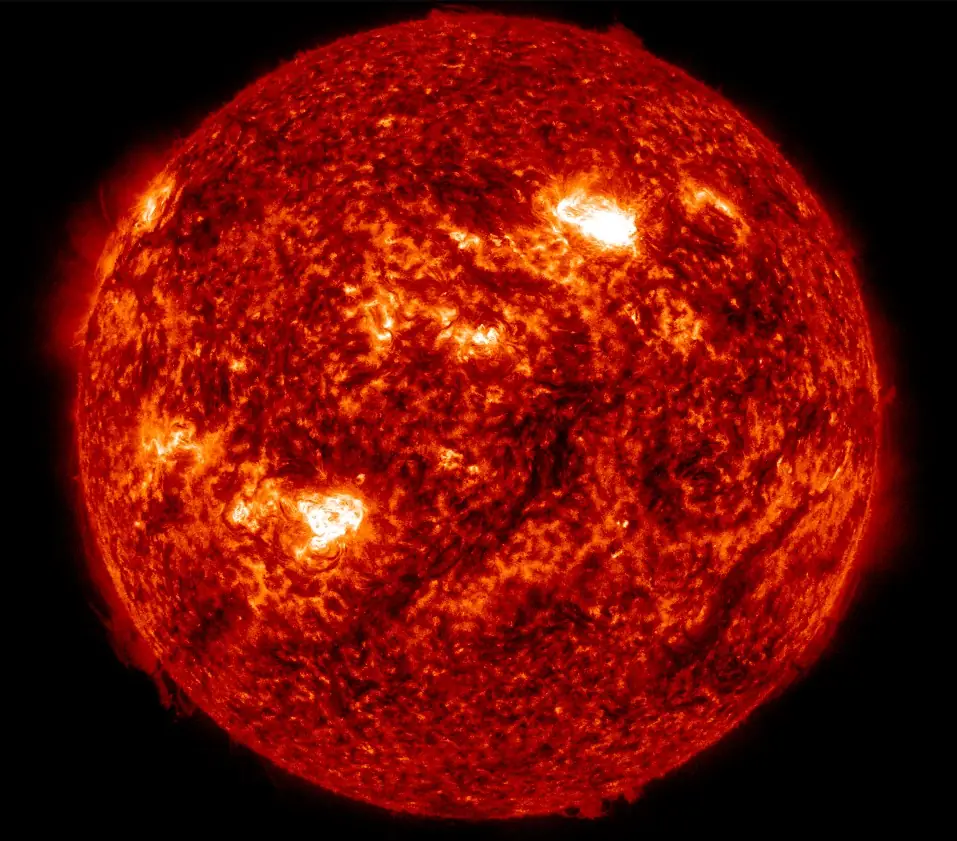

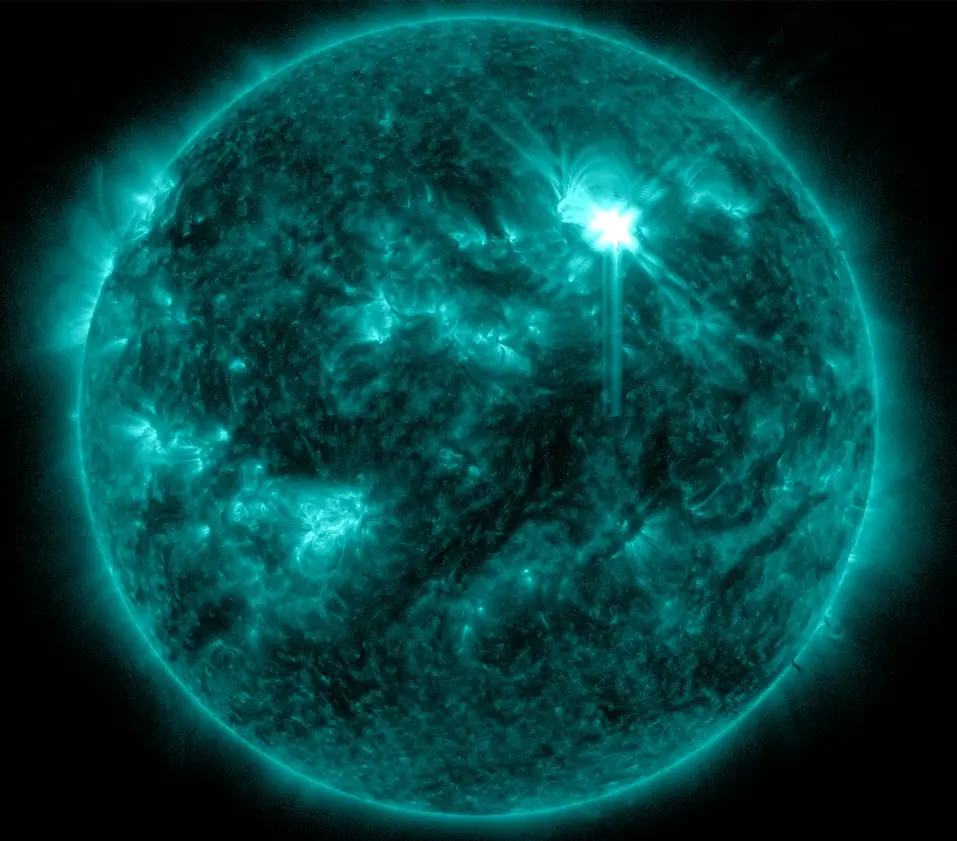

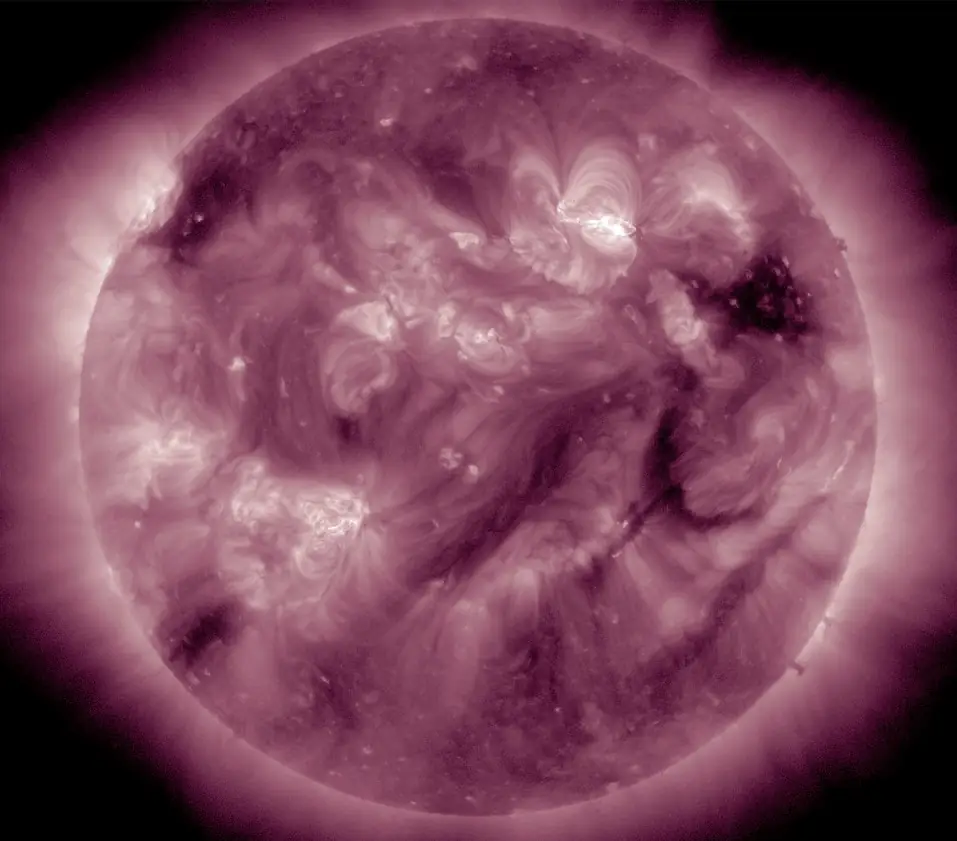

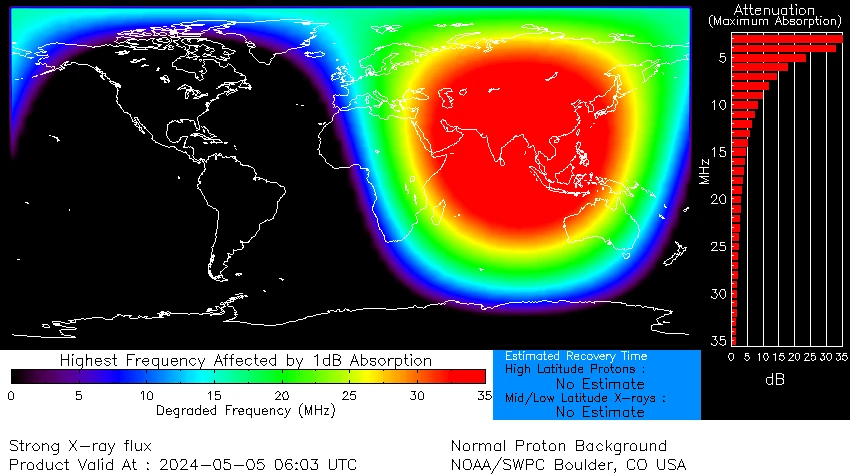

Solar activity was at moderate to high levels over the past 7 days, with multiple C- and M-class flares and 2 X-class.
| Max class | Time |
|---|---|
| M7.4 | 05/5, 10:00 UTC |
| M2.3 | 05/5, 09:38 UTC |
| M1.3 | 05/5, 08:19 UTC |
| X1.3 | 05/5, 06:01 UTC |
| M8.4 | 05/5, 01:27 UTC |
| M9.0 | 05/4, 23:48 UTC |
| M3.2 | 05/4, 22:37 UTC |
| M1.3 | 05/4, 18:20 UTC |
| M1.5 | 05/4, 07:07 UTC |
| M9.1 | 05/4, 06:19 UTC |
| M1.6 | 05/4, 00:36 UTC |
| M2.4 | 05/3, 23:30 UTC |
| M1.0 | 05/3, 23:16 UTC |
| M1.2 | 05/3, 22:47 UTC |
| M4.4 | 05/3, 08:11 UTC |
| X1.6 | 05/3, 02:22 UTC |
| M2.7 | 05/3, 00:15 UTC |
| M2.7 | 05/2, 20:57 UTC |
| M1.0 | 05/2, 02:17 UTC |
| M1.8 | 05/1, 22:31 UTC |
| M1.9 | 05/1, 14:44 UTC |
| M1.8 | 05/1, 14:32 UTC |
| M9.5 | 04/30, 23:46 UTC |
| M1.3 | 04/30, 16:33 UTC |
| M1.2 | 04/30, 15:11 UTC |
| M1.6 | 04/30, 01:14 UTC |
| M3.7 | 04/29, 01:11 UTC |
| M2.5 | 04/29, 00:48 UTC |
Region 3663 (beta-gamma-delta) produced an M9.1 flare at 06:19 UTC and M9.9 at 23:48 UTC on May 4. A Type II (estimated velocity 950 km/s) and Type IV radio sweep, along with a Tenflare, were observed with the M9.1 event.
A CME is suspected to be associated with the flare, however, coronagraph imagery has been unavailable since 23:37 UTC on May 3 due to an apparent outage.
Regions 3663 and 3664 (beta-delta) persist as the largest and most complex regions on the disk, with minor growth noted in both.
New Region 3667 (alpha) was numbered and the remaining regions were either stable or in decay over the past 36 hours.
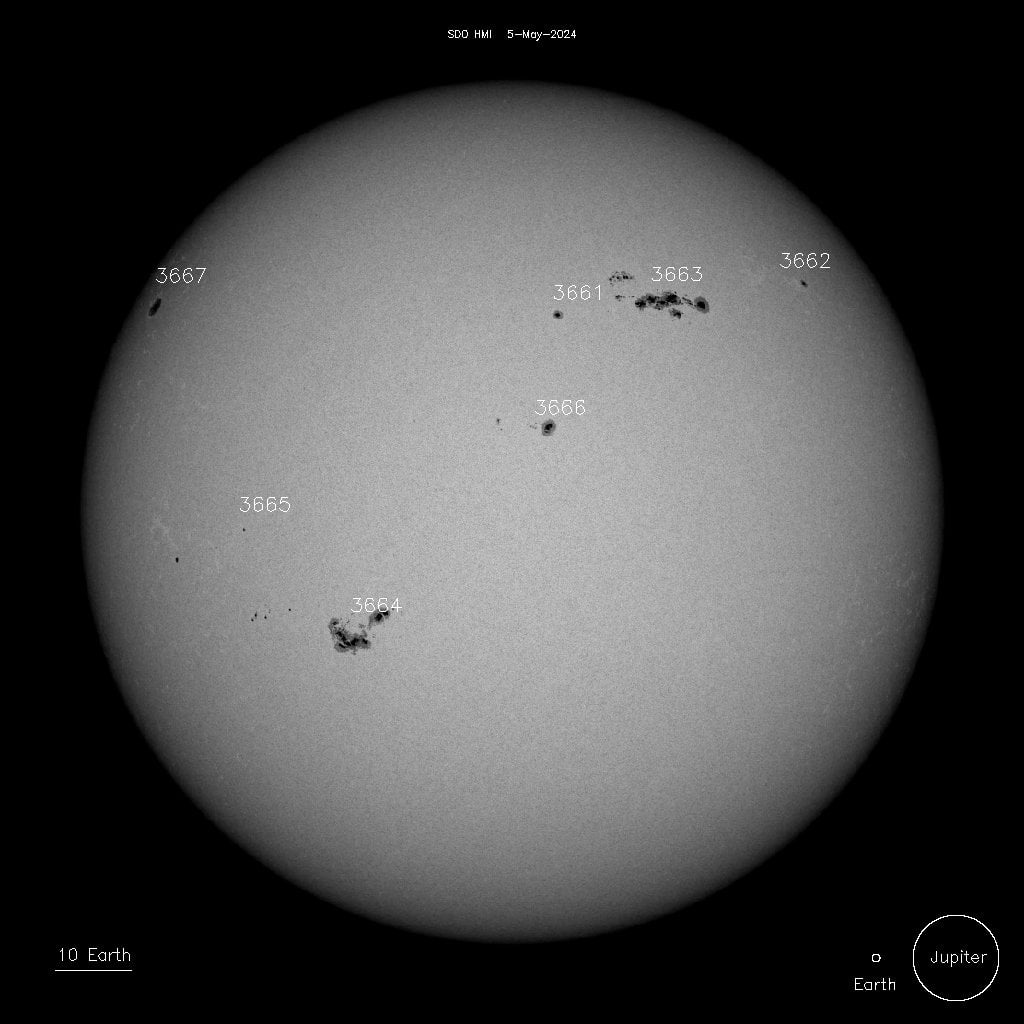

Other notable eruptive activity included a C3.9 flare at 20:37 UTC on May 03, with associated Type II (estimated velocity 392 km/s) and Type IV radio emissions, from an unspotted area to the east of Region 3666 (beta). The associated CME, first seen in SOHO/LASCO C3 imagery at 22:18 UTC on May 3, has been analyzed as a glancing blow hit on May 9.
Solar activity over the next 24 hours is expected to be at moderate levels (75% / M-class), with a chance for X-class flares (25%) through May 7.
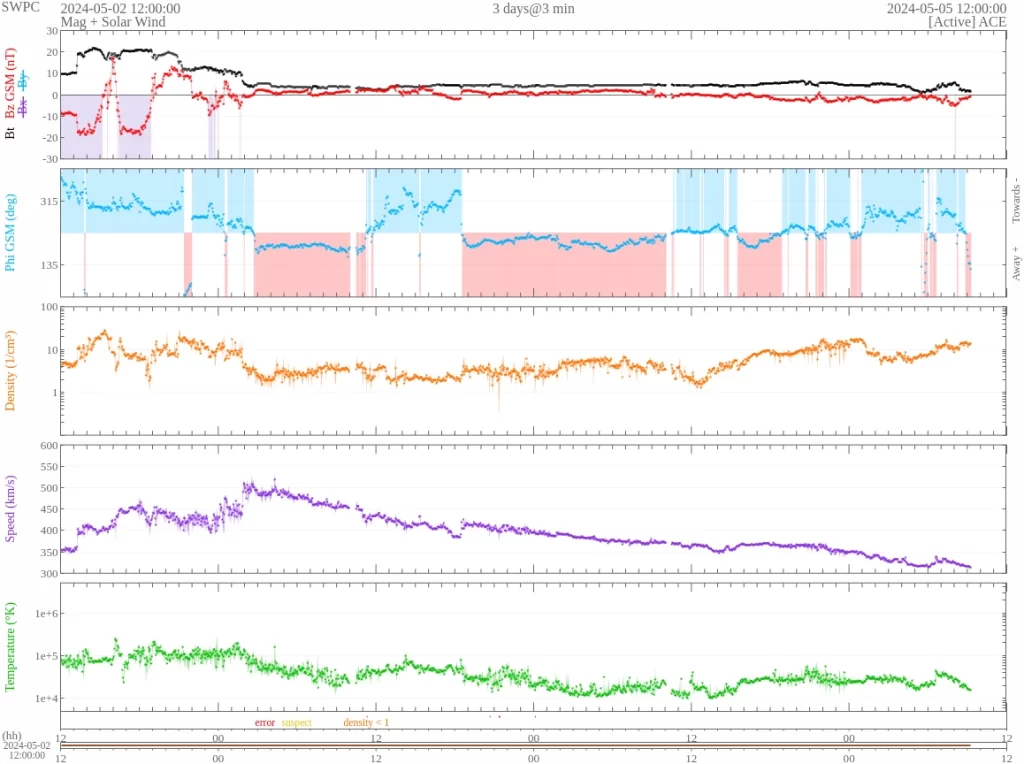

Solar wind exhibited ambient conditions over the past 24 hours. Total magnetic field strength was at or below 6 nT and the Bz component was between +/-3 nT. Solar wind speeds decreased throughout the period, from early readings near 400 km/s to around 350 – 370 km/s.
Mildly enhanced solar wind conditions and positive polarity coronal hole high speed stream (CH HSS) influences are likely to prevail through May 7. A stronger disturbance is expected late on May 5 and May 6 due to the anticipated arrival of the CME produced by the X1.6 solar flare on May 3.
References:
1 Forecast Discussion – Issued: 2024 May 05 0030 UTC – Prepared by the U.S. Dept. of Commerce, NOAA, Space Weather Prediction Center
Featured image credit: X1.3 solar flare on May 5, 2024. Credit: NASA SDO/AIA 131, Helioviewer, The Watchers
M9.1 solar flare erupts from geoeffective Region 3663
Saturday, May 4, 2024
X1.6 solar flare erupts from Region 3663, forecast calls for CME impact late May 5
Friday, May 3, 2024
Two stealth CMEs impact Earth, producing G3 – Strong geomagnetic storm
Thursday, May 2, 2024
Rare quadruple solar flare event on April 23, 2024
Wednesday, April 24, 2024
G2 – Moderate geomagnetic storm levels forecast as two more CMEs approach Earth
Wednesday, April 17, 2024
Two incoming CMEs to combine with CH HSS and produce G1 – Minor geomagnetic storming
Sunday, April 14, 2024
Long-duration M9.4 solar flare erupts from Region 3615
Sunday, March 31, 2024